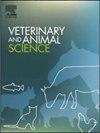添加热杀益生菌混合物可改善肉鸡肠道形态、抗氧化能力和肉质
IF 1.9
Q2 AGRICULTURE, DAIRY & ANIMAL SCIENCE
引用次数: 0
摘要
益生菌在家禽业中被广泛用于改善肠道健康和生产性能。然而,很少有研究探索热杀益生菌的作用。本试验研究了由枯草芽孢杆菌(Bacillus subtilis, BS)和植物乳杆菌28 (Lactobacillus plantarum, LP28)组成的热杀益生菌混合物对肉鸡生长性能、肠道形态、抗氧化能力和肉品质的影响。试验选用300只爱拔益加雏鸡,随机分为4个处理组(每组3个重复;25只/重复):CON(基础饲粮)、AB(基础饲粮+ 10 ppm enramycin)、LDP(基础饲粮+热杀LP28和BS,各1.0 × 108细胞/kg)和HDP(基础饲粮+热杀LP28和BS,各1.0 × 109细胞/kg)。每天记录采食量,在每个生长末期记录体重。试验第35天,每个处理12只鸡进行肠道形态和抗氧化能力分析,8只鸡进行肉质分析。采用单因素方差分析和Tukey检验进行组间比较,p <;0.05. 各组间生长性能无显著差异。HDP组绒毛高度和隐窝深度均高于CON和LDP组(p <;0.05)。与CON组相比,HDP组表现出更强的抗氧化能力,肝脏中谷胱甘肽过氧化物酶水平较高,胸脯肉中硫代巴比妥酸活性物质水平较低(p <;0.05)。与CON组相比,HDP组肉质更好,剪切力更低,粘稠度和嚼劲更高(p <;0.05)。综上所述,热杀益生菌可改善肉鸡肠道形态、抗氧化能力和肉质,可用于家禽业。本文章由计算机程序翻译,如有差异,请以英文原文为准。
Supplementation of heat-killed probiotics mixture improves intestinal morphology, antioxidant capacity, and meat quality in broilers
Probiotics are widely used to improve intestinal health and production performance in the poultry industry. However, few studies have explored the effects of heat-killed probiotics. This study investigated the effects of a heat-killed probiotic mixture, comprising Bacillus subtilis (BS) and Lactobacillus plantarum 28 (LP28), on the growth performance, intestinal morphology, antioxidant capacity, and meat quality of broilers. A total of 300 Arbor Acres chicks were randomly assigned to four treatment groups (three replicates per group; 25 chicks per replicate): CON (basal diet), AB (basal diet + 10 ppm enramycin), LDP (basal diet + heat-killed LP28 and BS, 1.0 × 108 cells/kg each), and HDP (basal diet + heat-killed LP28 and BS, 1.0 × 109 cells/kg each). Feed intake was recorded daily, and body weight was recorded at the end of each growth phase. Twelve birds per treatment were used for intestinal morphology and antioxidant capacity analyses, and eight birds were used for meat quality analysis on day 35. One-way ANOVA followed by Tukey test was performed to perform statistical comparison among groups at p < 0.05. No significant intergroup difference was observed in growth performance. However, villus height and crypt depth were higher in the HDP group than in the CON and LDP groups (p < 0.05). The HDP group exhibited a stronger antioxidant capacity, higher hepatic glutathione peroxidase levels in the liver, and lower thiobarbituric acid reactive substance levels in breast meat than did the CON group (p < 0.05). The HDP group also exhibited better meat quality with lower shear force and higher gumminess and chewiness than did the CON group (p < 0.05). In summary, heat-killed probiotics may improve the intestinal morphology, antioxidant capacity, and meat quality of broilers and can be utilized in the poultry industry.
求助全文
通过发布文献求助,成功后即可免费获取论文全文。
去求助
来源期刊

Veterinary and Animal Science
Veterinary-Veterinary (all)
CiteScore
3.50
自引率
0.00%
发文量
43
审稿时长
47 days
 求助内容:
求助内容: 应助结果提醒方式:
应助结果提醒方式:


